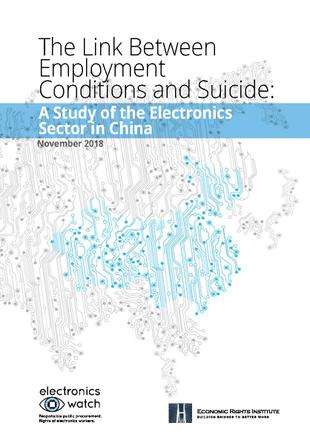Links Between Working Conditions and Employee Suicide - Study of the Electronics Sector in China
The Economic Rights Institute and Electronics Watch have released The Link Between Employment Conditions and Suicide: A Study of the Electronics Sector in China. The report analyses original quantitative and qualitative data to show how certain employment conditions heighten the risk of employee suicide.
The report suggests two "cycles of influence" that contribute to different forms of suicide. In one cycle employers use coercion and punitive forms of discipline to enforce productivity requirements. In the other cycle, employers use hiring requirements and incentives to ensure their flexibility to recruit and downsize, depending on the needs of production. These cycles can result in high levels of stress, depression, or insecurity, aggravated by forced overtime, fines and supervisor hostility in the one cycle, disputes with recruiters and employees struggling with dating and marriage in the other.
The Economic Rights Institute and Electronics Watch have issued a "call to action" for a multi-stakeholder taskforce to develop, implement, and monitor an action plan to effectively address employment conditions that heighten the risk of employee suicide in the electronics industry.
Among other measures to prevent employment conditions from contributing to the risk of suicide, the report suggests the need to:
- End "soft" forms of forced labour, including forced overtime and restrictions of workers' right to resign from their jobs without forfeiting their wages.
- Abolish punitive forms of discipline and intervene effectively to prevent hostility and violence in the workplace.
- Empower workers to collectively influence enterprise decisions connected to conditions that heighten risk of employee suicide, including productivity requirements, overtime and the structure of incentives.
The report is not intended to expose any single firm but rather seeks to highlight the connection between the phenomenon of employee suicide and systemic employment issues which will only be resolved through the collaborative efforts of industry, government, civil society and other experts.
See full press release and academic perspectives on the report.


